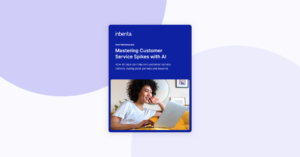Over the past several decades, customer experience has grown into a critical component of any company’s success. In our fiercely competitive digital world consumers are more powerful than ever and points of contact are ever more numerous and broad-reaching. Via social media, email, forums and other websites, by phone or text, customers expect to contact the company on their own terms, and they expect a correspondingly swift and focused reply to their inquiries.
What makes a difference between two excellent products on a market? Top-notch customer service with fluid interactions, at every step from pre-sales to post-sales. In this article, we will explore ticketing system basics and how they enhance customer retention and team performance.
Description of a ticketing system
What is a ticket?
The word “ticket” commonly refers to a piece of work slated to be done by an IT support team – tasks such as bug fixes and other user requests, or any other operation in the technology environment. Applying this usage to the customer service environment, any customer issue or request generates a “ticket” that is tracked into a system all along its life cycle:
- Submission of a request by the client.
- Creation of a support ticket shared to the customer and the representative.
- Assignment of the ticket to a dedicated representative.
- Sending status to other departments.
- Resolution of the request and closing the case.
The ticket connects representative and customer, enabling them to communicate and follow progress on the topic through one clear thread.
What is a ticketing system?
A ticketing system is a tool that monitors and documents customer interaction with customer service representatives and helps efficiently manage the flow of incoming contacts, whether from consumer sites, social media, or online forums. The system processes and catalogs different requests, tracing the progression of each case from customer request to solution and closing.
When a ticket is created, it is assigned to a customer service representative. This representative will start working on the ticket and keep the customer informed. The customer can also reach out at any time to customer service using that same ticket. The relevant representative will receive a notification and be able to reply immediately.
Once a case is closed, it remains archived in the system, so repetitive requests can be utilized to generate frequently asked questions (FAQs), or forum responses via a company representative, enabling customers to find an immediate answer whenever one is required, without needing direct support.
Three reasons why you should adopt a ticketing system software
Managing incoming requests without a specific system is certainly possible, to a certain extent. As your company grows and your staff gets busier support requests become more numerous and the risk of missing a case and thus leading to client dissatisfaction grows. A solidly designed ticket-based organization makes the difference.
Improved team performance thanks to smarter workflows
A good system streamlines work process and improves workflow. Instead of processing customer requests piecemeal across your team as they are received, all incoming customer requests are entered into a central database. Sorted and labeled according to priority, category, or frequency, tickets are assigned automatically to specific agents, priority and critical issues are highlighted and dealt with first. Multiple cases can be dealt with at once, and inquiries already processed in the past can be addressed simply with preset responses. All in all, you enable your agents to process more requests in less time, with a greater degree of customer satisfaction.
Enhanced communication thanks to multiple channel support
Having an efficient, highly reactive customer service naturally increases the level of client’s satisfaction, but what clearly enhances loyalty is the overall experience. Clients want to be able to communicate with brands whenever and however they want, thus it is crucial to offer different possibilities for interaction. Ticketing tools gather requests from multiple channels of communication and centralize them, improving the flow and management of interactive inquiries. There may be multiple points of contact, but there is only one ticket and one thread of discussion per case. Giving your customers the means to effortlessly follow the processing of their requests (thanks to that ticket number) clearly helps develop relations of trust and transparency.
Better decision making thanks to reporting and analysis
Tracking customer service outcomes through a ticketing system can help significantly to improve team and manager decision making. A compiled record of all tickets is an obvious window into the performance of a customer service team – pure and direct data illustrating how quickly and efficiently tickets were solved by your team over any period of time and across any number of other criteria. Such a clear picture of how your team performs will allow you to identify areas for improvement, and more importantly the most efficient methods of improvement, over time. A ticketing system also enables a management team to spot broader problems and how they impact your daily business operations.
Things to consider when choosing a ticketing system software
You are by now perhaps wondering what the differences between one ticketing system and other may be, and how to identify the best fit for the needs of your company, your employee and their workflow, and your customer. Here are some elements that can guide your reflection.
Key functionalities
As discussed in the previous part, some functionalities help you meet team performance, client satisfaction and decision-making needs. You will most certainly want to look for the following:
- Accessibility: both the back-office and client portals should be user-friendly.
- Multi-channel support: ability to manage requests coming from different sources.
- Workflow automation: the means to automate customer service processes.
- Reporting and analysis: real-time visibility and performance/outcome assessment.
Symbolic AI-powered ticketing systems
The technology behind your chosen ticketing system plainly will have a significant impact on the quality of the service provided by a given system, and thereby on your customer service performance. Inbenta’s Ticketing module is based on Symbolic AI and uses our patented and proprietary Natural Language Processing technology. That technology enables our Messenger module to understand user requests and questions, regardless of their vocabulary or misspellings, and to provide those users with suitable replies and a smoother, more effective user experience.
A ticketing system paired with live chat
Chatbots are certainly perfect for clients who want a fast reply on a simple issue. However, some clients are most comfortable interacting with an actual human being. Giving the client the option to use a self-service solution and/or be personally guided by the support team is the best way to satisfy everyone’s needs. Inbenta has combined a live chat solution with a multichannel case management and ticketing system, making it possible to collect inquiries coming from different platforms (social media, website request entries, emails etc.) and convert them into a single thread. It is thus possible to naturally escalate from a chatbot to a real advisor.
Now that you understand how ticketing systems work, you might be interested in discovering the platform that industry leaders such as Groupon, Konica Minolta or Benefit Cosmetics have chosen to reduce their customer issue resolution times.











